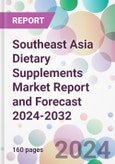According to the report, the Southeast Asia dietary supplements market is projected to grow at a CAGR of 7.80% between 2024 and 2032 to reach a value of about USD 16.12 billion by 2032. Aided by the consumer preference for wellness-focused products and the rising need for nutritional supplementation among the older population, the market is expected to grow significantly by 2032.
Dietary supplements comprise a wide variety of products intended to supplement the diet and provide nutrients, including vitamins, minerals, fibre, fatty acids, or amino acids. They come in various forms, such as tablets, capsules, powders, and liquids, and they play an essential role in maintaining overall health, boosting immunity, and preventing diseases. Apart from their health benefits, dietary supplements are increasingly viewed as a vital part of balanced nutrition, contributing to their widespread use.
The growing consumer interest in health and wellness is a significant driver of the Southeast Asia dietary supplements market growth. With the increasing awareness of the health benefits associated with regular consumption of dietary supplements, there has been a substantial shift towards a more health-conscious lifestyle. This trend has resulted in a surge in demand for dietary supplements across the region. The increasing ageing population and rising health concerns amongst millennials and the younger generation are further fuelling this trend.
The broadening applications of dietary supplements across different demographics are also contributing to the market expansion. For example, in the sports and fitness industry, dietary supplements are used to enhance performance, recovery, and muscle growth. For older adults, certain dietary supplements can support bone health, boost immunity, and improve overall wellness. The increasing consumer awareness about these benefits is propelling the market growth.
Additionally, the expanding distribution channels, including e-commerce, are providing an impetus to Southeast Asia dietary supplements market outlook. The ease of online shopping, coupled with a wider range of product availability, has led to an increase in online sales of dietary supplements. As internet penetration continues to increase in Southeast Asia, the online dietary supplements market is expected to grow rapidly.
Moreover, the rising prevalence of lifestyle diseases and increasing healthcare costs have led to a heightened focus on preventative healthcare, thereby augmenting the Southeast Asia dietary supplements market demand. The growing middle-class population and improving disposable incomes in the region also support market expansion.
Dietary supplements comprise a wide variety of products intended to supplement the diet and provide nutrients, including vitamins, minerals, fibre, fatty acids, or amino acids. They come in various forms, such as tablets, capsules, powders, and liquids, and they play an essential role in maintaining overall health, boosting immunity, and preventing diseases. Apart from their health benefits, dietary supplements are increasingly viewed as a vital part of balanced nutrition, contributing to their widespread use.
The growing consumer interest in health and wellness is a significant driver of the Southeast Asia dietary supplements market growth. With the increasing awareness of the health benefits associated with regular consumption of dietary supplements, there has been a substantial shift towards a more health-conscious lifestyle. This trend has resulted in a surge in demand for dietary supplements across the region. The increasing ageing population and rising health concerns amongst millennials and the younger generation are further fuelling this trend.
The broadening applications of dietary supplements across different demographics are also contributing to the market expansion. For example, in the sports and fitness industry, dietary supplements are used to enhance performance, recovery, and muscle growth. For older adults, certain dietary supplements can support bone health, boost immunity, and improve overall wellness. The increasing consumer awareness about these benefits is propelling the market growth.
Additionally, the expanding distribution channels, including e-commerce, are providing an impetus to Southeast Asia dietary supplements market outlook. The ease of online shopping, coupled with a wider range of product availability, has led to an increase in online sales of dietary supplements. As internet penetration continues to increase in Southeast Asia, the online dietary supplements market is expected to grow rapidly.
Moreover, the rising prevalence of lifestyle diseases and increasing healthcare costs have led to a heightened focus on preventative healthcare, thereby augmenting the Southeast Asia dietary supplements market demand. The growing middle-class population and improving disposable incomes in the region also support market expansion.
Market Segmentation
The market can be divided based on type, form, and country.Market Breakup by Type
- Vitamins
- Minerals
- Enzymes
- Fatty Acids
- Proteins
- Others
Market Breakup by Form
- Tablets and Capsules
- Powders
- Liquids
Market Breakup by Country
- Indonesia
- Singapore
- Vietnam
- Thailand
- Malaysia
- Philippines
Competitive Landscape
The report looks into the market shares, plant turnarounds, capacities, investments, and mergers and acquisitions, among other major developments, of the leading companies operating in the Southeast Asia dietary supplements market. Some of the major players explored in the report are as follows:- Abbott Nutrition
- Nestlé S.A.
- Glanbia plc
- PT. Indopasifik Teknologi Medika Indonesia
- PT Kalbe Farma Tbk
- GlaxoSmithKline plc.
- Nu Skin Enterprises Inc.
- Others
Table of Contents
1 Preface2 Report Coverage - Key Segmentation and Scope4 Key Assumptions6 Market Snapshot7 Opportunities and Challenges in the Market15 Industry Events and Developments
3 Report Description
5 Executive Summary
8 Asia Pacific Dietary Supplements Market Overview
9 Southeast Asia Dietary Supplements Market Overview
10 Southeast Asia Dietary Supplements Market by Type
11 Southeast Asia Dietary Supplements Market by Form
12 Southeast Asia Dietary Supplements Market by Country
13 Market Dynamics
14 Competitive Landscape
List of Key Figures and Tables
Companies Mentioned
- Abbott Nutrition Nestlé S.A.
- Glanbia plc PT.
- Indopasifik Teknologi Medika
- Indonesia PT
- Kalbe Farma Tbk
- GlaxoSmithKline plc.
- Nu Skin Enterprises Inc.








